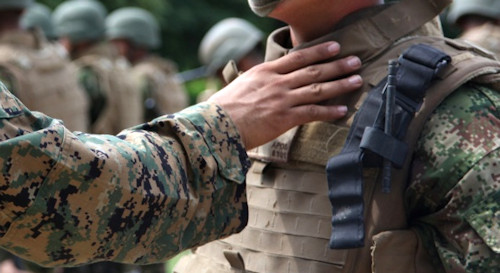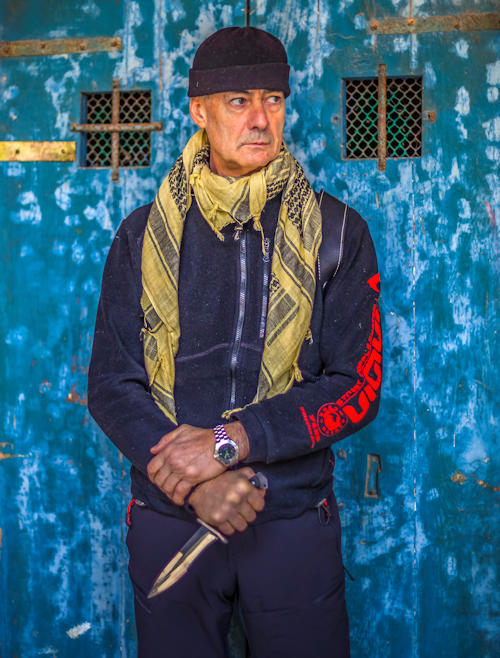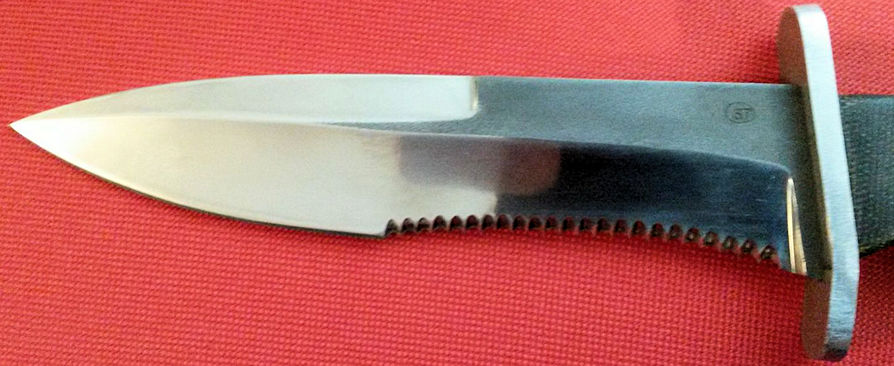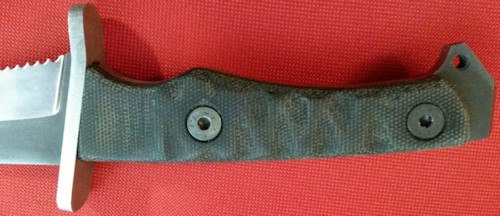Three seconds and the enemy is dead! The Doge 107 military combat knife, of the category Combat-Survival Knife, designed and created for the special bodies by the designer Sandro Martinelli, it is the perfect synthesis of a lethal weapon and of what is needed in a real action. In fighting there are no second decisive opportunities and the good moment is one and unrepeatable. Failing him would put at risk his own safety and the mission itself. According to Martinelli, a talented oplologist (scholar of weapons), "Any knife is a lethal weapon and in the military it must possess technical and ergonomic specifications appropriate to combat and survival. The path used to conceive, design, test and produce a combat knife is very long and nothing is born at random and everything is studied in detail". Online Defense collected how and why we came to conceive the prototype of the 107 Doge.
Choice of the name
Doge 107 perfectly embodies the spirit of the fighter from the name, as "Doge" in Venetian also means commander, nickname of the late lieutenant Francesco Finzi, considered by the Lagunari of Venice as the best trainer and survival instructor of the explorers of all time. 107 is the code that distinguishes amphibious explorers with green berets. In this case the designer thus makes honor and homage to his teacher.
Frame priorities for use
The extensive martial and military experience of the designer, qualified FISFO instructor, Kali Eskrima, Italian Military Tradition (Arditi), Modern Arnis, explorer of the Lagunari and instructor of the same for three years, has greatly influenced the final product. The parameters evaluated are spaced from the extraction speed to the lethality in terms of time. A research and analysis work that lasted two years with many exchanges of opinion with the Grand Master Bram Frank (very well known by American and Israeli military knife specialists). Everything has led the designer to turn to a double-use knife, because the special bodies need a pure combat knife that also guarantees survival.
Difficulty of the special forces operator
 Attack on a few points uncovered without errors, because instruments, body armor and weapons reduce the areas to be hit. Therefore, the knife must be hard enough not to break or be damaged in the possible impact with a ballistic plate of the bulletproof vest or other, including bones, but not too hard because it must allow a certain softness in the parades to absorb impacts. It must also be anti-reflective and easy to recover. According to the designer: "It is mainly a lethal tool, always and in any case, and only in the suborder of survival ". The special forces operator in action has a few useful seconds and requires reliable weapons. In survival the dagger is sharpened in speed on the stones of the place. All this is crucial!
Attack on a few points uncovered without errors, because instruments, body armor and weapons reduce the areas to be hit. Therefore, the knife must be hard enough not to break or be damaged in the possible impact with a ballistic plate of the bulletproof vest or other, including bones, but not too hard because it must allow a certain softness in the parades to absorb impacts. It must also be anti-reflective and easy to recover. According to the designer: "It is mainly a lethal tool, always and in any case, and only in the suborder of survival ". The special forces operator in action has a few useful seconds and requires reliable weapons. In survival the dagger is sharpened in speed on the stones of the place. All this is crucial!
Lethal in three seconds
With one shot, well directed and in the right place, in three seconds you die! According to the major WE Fairbairn, who has thoroughly studied the problem (see table summary "Get Tough", Edition of 1943) there are various points to hit.
In practice, many points are covered by tools and body armor: 4, 5 and 6 points, which correspond to the subclavicular (loss of consciousness in 2 "and death the 3" and a half), to the heart and the stomach: lethal in 3 seconds. The cover creates considerable problems because the key factor is missing: death in 3 ". You can hit the subclavicular despite being in the presence of the bulletproof vest, but acting from behind and entering the collar with absolute precision.

The other points are the brachial artery that guarantees the loss of consciousness in 14 seconds and death in 1'30 "; the radial artery leads to loss of consciousness in 30 ", to death in 2"; finally the carotid in 5 "to lose the senses and 12" to death. Times too long! So the special forces operator would be too exposed and would have no guarantee that the opponent can not make noises or report the attack. There are other points such as the femoral aorta, the cerebellum, the eye, but for the purposes of the ambush or the combat they are not absolutely practical to hit for various reasons.
What kind of injury?
According to the manual of the Scientific Police, by Rocco Paceri - Third edition revised and corrected by Salvatore Montanaro - the incised or blade wounds are those produced by a well-defined clean cut. They can only damage the epidermis, but often they reach up to the dermis or the subcutaneous, reaching also the underlying organs. They are considered to be scalding wounds when they affect the anterolateral regions. In the pounding and cutting wounds: the tip opens the way but the real work does the thread that cuts the fabrics.

Analyzing other documentation and specifically only the cutting wound, it affects skin and subcutaneous tissues, and only exceptionally deep internal organs. Three types of wounds: linear, flap and mutilant. The first two cut the fabrics, while the third type amputates the enemy only with reduced diameters (eg nose and fingers). The cut therefore creates a more or less large lesion and the same can vary with the inclination of the blade impact with the skin.
The cut generated on a flat surface is called "codetta" and is deeper and more decisive at the entrance than at the end of the stroke. But if the cut is done on a curved surface it is produced "The inversion of the codette" with the deeper internal wound at the end of the stroke than at the beginning. This aspect must be taken into account especially in the blows at the neck because this is explained by the angle of impact of the blade, which is located in a tangential position, with respect to the skin. According to this principle, the most suitable area in action, and easy, is the neck: there are very important vascular structures such as the carotid artery, the jugular vein, the vagus nerve, the larynx, the trachea in the last cerebral bodies. A cut in this area also leads to death by internal drowning from blood due to occlusion of the airways. These wounds are called by scannamento and if they also affect the trachea they prevent the victim from making sounds or complaints.
In the case of the wrists, as far as the opposite is concerned, the fatal wound with hemorrhagic-hypovolemic shock is rare, because the radial artery is deep and not easily reached. The wrists are cut to sever the tendons of the flexor muscles, so as to disarm and prevent the combat with the weapon in hand.
Tip and bit-edged lesions are addressed deep rather than on the surface. They are the most suitable for this purpose to generate a quick death, as two distinct forces come into play: compression and cutting. In this case it recedes deeply. Here's how much the wound can vary based on the following factors:
- traction of elastic and intracorporeal fibers with partial or total entry of the blade;
- possible further damage from external rotation during the blade extraction phase due to the flexor muscles (biceps-brachialis) of the arm.
In action with the knife the most indicated vital part is the upper left area of the trunk: heart and aorta. But they are protected from the ribs and the sternum and reaching them requires a special technical skill because at the time of the bet you have to rotate the hand and bring the thread and the coast horizontal to the ground so as to pass between the ribs and reach the objectives.

Steel, blade, handle and change of attachment
According to the design philosophy of the Doge 107, the blade, which is the part dedicated to offense or work, (divides into proximal third, which we can define as "strong" as close to the handle, in median third, or the central part of the knife and in distal third or "weak" that refers to the tip) is made of 440C steel with hardness (Rockwell) HR 57 / 58. You can sharpen with wet stone in speed in the operating theaters. While the sharpening angle is 19 °. The knife falls into the category daggers because long 27,4 cm in total and divided into 15 cm blade, 4 mm guard, 12 cm handle. Weight 305 gr. Above the 35 cm it would become dagger. To protect the hand is the guard with the guard arm (forward quillon) on the side of the thread; and the parade arm (rear quillon) on the side of the coast. The latter moved forward for greater control and comfort to the thumb. The guard must absorb and brake "kneading" the opposing blade, thus avoiding slips or jumps. For this reason a softer steel is used.
 The designer gave more importance to the rushes because the experience of the Arditi alone provides the explanation to the shape of the spearhead (Spear Point) which has the pointed ogival profile and the apex a little above the center of the bevel, so it is a perfect variant for special forces. The tip is sturdy for all types of bets made by gripping the dagger in the manner Ice Pick Hold, Oriental Hold, Straingh Hold, Slash Hold.
The designer gave more importance to the rushes because the experience of the Arditi alone provides the explanation to the shape of the spearhead (Spear Point) which has the pointed ogival profile and the apex a little above the center of the bevel, so it is a perfect variant for special forces. The tip is sturdy for all types of bets made by gripping the dagger in the manner Ice Pick Hold, Oriental Hold, Straingh Hold, Slash Hold.
The bevel (Bevel) it is concave and at the meeting of the two forms the cutting edge. Just above the middle of the bevel one can notice an interesting thorn (Plugs) or arista or reinforcement nerve. The maximum thickness is 4,5 mm. In the upper part we see the back (spine or back) that for half of the length is at living angles of 90 °, very useful for survival for the creation of sparks. The other half is half a thread, useful for combat in the transition between the various angles of attack and in the episodes because it penetrates more easily. It is noteworthy that the third distal and the proximal third superior and inferior of the blade have crossed the median third. The counter-scoring (False Edge) located in the distal third, it was obtained from the coast with a pruning in order to increase the chances of cutting in the extrarotation of the body. What instead of a false cut, (Swdge), he would not have guaranteed.
The lower part is a combined cutting edge (Combo Edge). Also in this case the thirds have been crossed, becoming half flush (Cutting Edge) and the other half with serrated edge (Serrated Edge) arched. The thread Combo it is very useful in action because the serrated part, considerably longer than normal, with chisel edge allows to cut with absolute effectiveness any type of natural or synthetic fabric, especially adapting itself to the physical morphology of the wrist. This device was used to cut the flexor tendons of the wrist (inner part) when covered by the glove or camouflage, in order to make the weapon fall to the opponent.
 The balance of the dagger is moved towards the handle to allow greater roteability in action.
The balance of the dagger is moved towards the handle to allow greater roteability in action.
The handle (Grip) consists of two G10 or micarta grips fixed to the integral shank (through shank) by two rivets. For example, the choice of micarta, material of phenolic resins and layers of fabric or paper is suitable for the purpose because it resists impacts and is anticorrosive. The ergonomic handle has a particular hint where it positions the index, in order to improve grip, especially in extraction.
At the end of the handle is the enlarged head break (Skull Crusher) with an eyelet for the dragon (Lanyard Hole or Thong Hole) to secure the hand grip.
The problem of extraction from the body
When you stab deep, a person can penetrate from 3 to 5 cm between skin, fat and muscle. Once passed this critical threshold, the winding effect is incurred and the recovery of the knife becomes difficult. It is a serious problem and debated at length among the experts of the sector for several reasons, but the main one is the lack of immediate recovery of the dagger. According to the designer's philosophy, this problem is solved with Teflon.

Treating the blade with the special film increases surface smoothness. Therefore he opted for a layer of 0,010 mm of KG Gun-Kote which is not only protective against corrosion and wear, but has a significant Teflon component (PTFE). In this way the dagger becomes anti-reflective, resistant to wear and sliding. Suffice it to say that the thin layer resists 1000 hours of salt fog, 1000 hours immersed in water at 37 ° C and 60 days of immersion in sea water. It has thermal break at 500 °.
Realization of the prototype and real tests
The prototype (custom) was handcrafted involving two master cutlers: Stefano Trentini for the prototype polished steel; Riccardo Caregnato for the teflonate. The result of their handicraft work was then tested for three months by Major Vito Pansini of the Lagunari of Venice. A true and important test for the stress of the materials used. Regarding the part of the cut of the meat, tendons, bones, arteries and "windy effect" the designer used scraps of production of a friend butcher.
Last phase
The dagger will continue its process going into production. The choices of the materials could be different or maybe not, but this is another story ...
(photo: Stefano De Grandis / Sandro Martinelli / US Marine Corps)












